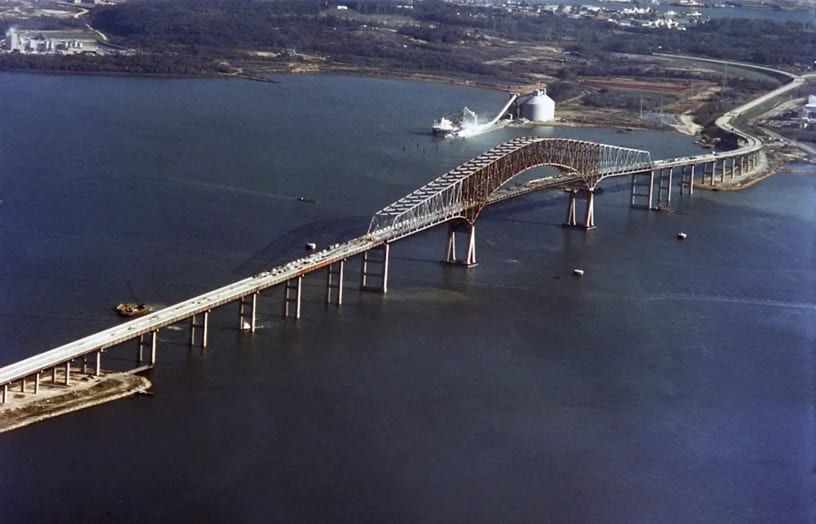Kofi Britwum, Assistant Professor of Farm Management, britwum@udel.edu
Nate Bruce, Farm Business Management Specialist, nsbruce@udel.edu 
Figure 1. Francis Scott Key Bridge. Baltimore, Maryland.
Within 40 seconds on the fated morning of March 26, 2024, the Francis Scott Key Bridge collapsed and tragically claimed the lives of six construction workers. The timing of the catastrophe, in the wee hours of the morning, spared potentially greater casualties had it happened later in the day, during rush hour. The bridge’s collapse temporarily halted marine traffic at the Port of Baltimore. Prior to the bridge’s collapse and subsequent suspension of normal shipping operations, the Port of Baltimore functioned as a vital trade hub in the eastern corridor of the US.
In 2023, the port is estimated to have handled 52.3 million tons of international cargo valued at approximately $81 billion. To put this in context, this places the Port of Baltimore within the top 20 ports nationwide in terms of total tonnage and container handling, according to the Department of Transportation. In addition, it was ranked ninth in terms of value and handling of international cargo. It served as the leading hub for “roll on, roll off” cargo in the US, comprising of automobiles, construction, and farm equipment (wheeled cargo). Major agricultural commodities and products were transported through the ports in 2023 and included sugar, soybeans, corn, wheat, coffee, and various produce items.
Fortunately, the temporary closure of the port will have only a minor effect on the overall US economy, although its impact will be somewhat significant in Maryland. According to a post by IMPLAN, approximately 15,000 individuals were employed at the port, and its temporary closure is expected to result in the loss of approximately $275 million in labor income. This could potentially reduce Maryland’s Gross Domestic Product (GDP) contribution by about $286 million, with ripple effects on tax revenues.
Since agricultural commodities and products were handled through the port, a valid question is whether the closure will broadly affect agricultural trade. Not substantially at least. In 2023, exports through the port accounted for approximately $650 million, with tonnage of approximately 605,000 MT; this represented about 0.4% of total US agricultural exports by value. Imports of agricultural products through the port were equally small, estimated at 1.7% of the value of overall US agricultural imports.
For the state of Delaware, thanks to a thriving poultry industry, most of the soybean and corn produced are absorbed for chicken feed; therefore, the port closure is not expected to impact grain agriculture to any meaningful degree. Similarly, the Mid-Atlantic region consumes a large share of poultry products from the state, with just about 10% to 15% of Delmarva poultry exported overseas. Consequently, the impacts on poultry exports are not expected to be considerable for the state.
However, impacts are likely to be felt in key agricultural imports that came through the ports – in particular, fertilizer and farm machinery. The Port of Baltimore handled significant fertilizer imports, including nearly all of the nitrogen fertilizer (both UAN and urea) used on the eastern shore. Additionally, about half of the supply of potash used locally also comes through the port. Due to the port’s closure, fertilizer imports will be redirected to other major ports on the East Coast. For the purpose of planning, local producers in Delaware should consider budgeting for higher fertilizer expenses due to increased shipping costs. For nitrogen expenses, producers should consider increasing the budgeted cost per pound of nitrogen by $0.10 – $0.20 due to increased logistical costs. While the port has been a primary hub for handling cars, light trucks, and farm equipment, local equipment inventories for this production year are not expected to pose a problem. This could, however, change in the future depending on how long the port remains closed.
Although the port closure is by no means minor, robust supply chains post-Covid-19 have generally mitigated large-scale economic impacts in Maryland and surrounding regions. President Biden has assured federal funding for the bridge’s reconstruction within the shortest possible time, though it may still take a while before a new bridge is up and fully operational. Thankfully, Maryland officials anticipate a reopening of the port by the end of May with a few temporary passages already underway for smaller vessels and barges.
